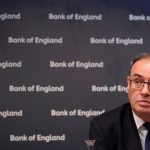
LONDON (Reuters) – The Bank of England’s first interest rate cut in more than four years will help to foster a cautious sense of optimism about Britain’s long-struggling economy, but the scale of the growth challenge facing the new government remains huge.
The BoE lowered its benchmark rate to 5.0% on Thursday, from a 16-year high of 5.25%, offering a bit more relief to households and businesses who are emerging from the inflationary shocks of the COVID pandemic and Russia’s invasion of Ukraine.
Data published a few hours before the BoE announcement showed British manufacturers enjoyed a stronger July than their peers in much of the rest of Europe and Asia.
British shares (L) – which have underperformed since the 2016 Brexit vote – added to recent gains after the BoE’s rate cut, with the FTSE 250 index of medium-sized firms hitting its highest since February 2022, before following other markets and falling later in the day on worries about the U.S. economy.
The lowering of Bank Rate from its 16-year high and the signs of economic recovery after a shallow recession in 2023 are helpful for new Prime Minister Keir Starmer, who has made economic growth – chiefly via reforms to boost the country’s weak productivity growth – the top priority of his government.
BoE Chief Economist Huw Pill, who voted to keep rates on hold, welcomed the improved outlook for the economy, even if it still represented a historically tepid pace of growth at around 1% a year between 2024 and 2026.
“That sort of rate, you know, that’s better than what we’ve seen,” Pill said. “But at the same time, I think it’s fair to say it’s not something that we should get too complacent or enthusiastic about.”
Michael Browne, chief investment officer of Martin Currie, part of asset management group Franklin Templeton, said the likelihood of further BoE rate cuts would help to foster the sense of turnaround in Britain.
“In this environment, we continue to favour the interest rate-sensitive sectors of house builders, real estate, utilities and in particular the green energy sector,” he said.
REASONS TO BE CAUTIOUS
The BoE’s announcement came three days after finance minister Rachel Reeves announced a big public sector pay rise in the first move of her economic policy programme that seeks to double Britain’s pace of economic growth to around 2.5% a year.
But there are a host of reasons for continued caution.
The narrow 5-4 vote in favour of a rate cut by the BoE’s Monetary Policy Committee underscored the extent of inflation risks still hanging over the economy.
Governor Andrew Bailey was at pains to stress that the BoE was not at the start of a series of swift cuts to borrowing costs, saying the stronger performance of the economy in recent months could keep inflation risks on the radar.
Suren Thiru, economics director at accountancy body ICAEW, said the rate cut marked a notable shift in direction but the financial reality facing households and firms had not changed.
“This is just one step back from the previous period of 14 rate hikes,” Thiru said.
Investors are fully pricing only one further cut to interest rates by the BoE later this year.
At almost 6%, wage growth is running at about double the rate that would normally be consistent with the central bank’s 2% inflation target.
And while the BoE sharply raised its forecast for Britain’s economic growth in 2024 to 1.25% from a previous 0.5%, potentially putting it ahead of France and Italy, as well as Germany – that improvement reflected the stronger start to this year rather than a rethink about the outlook.
The central bank left unchanged its estimates for growth in 2025 and 2026 at 1% and 1.25%, less than half the average before the 2007-08 global financial crisis.
In her response to the BoE’s interest rate cut, Reeves stressed the hard road ahead, with borrowing costs still putting pressure on many households and the public finances under strain, raising the likelihood of tax increases in her first budget in October.
“That is why this government is taking the difficult decisions now to fix the foundations of our economy after years of low growth,” she said.
To read the full article, Click Here

